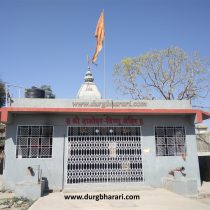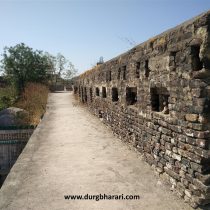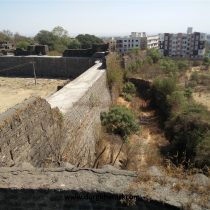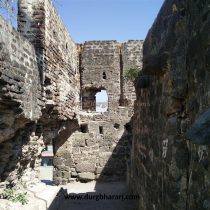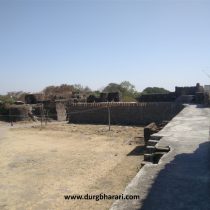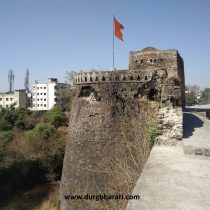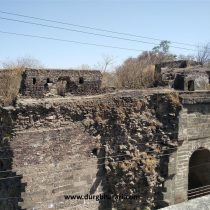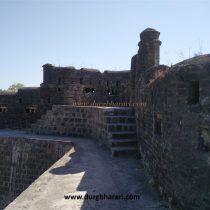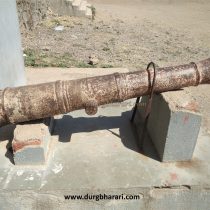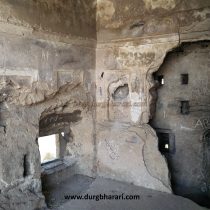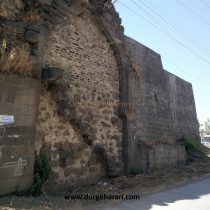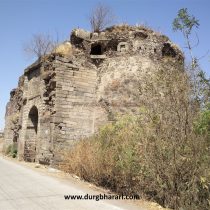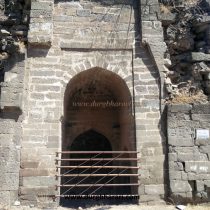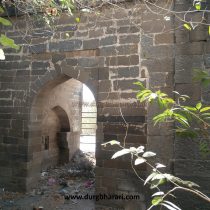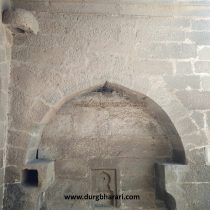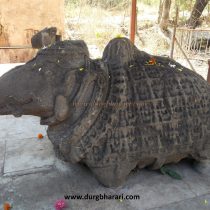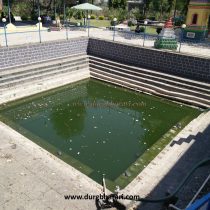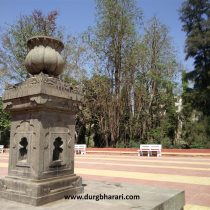CHAKAN AKA SANGRAMDURG
TYPE : GROUND FORT
DISTRICT : PUNE
HEIGHT : 0
GRADE : EASY
In ancient times, the Chakan ground fort was built to protect the trading center at Chakan. The present condition of this fort, which has an ancient and glorious history, is very bad. Sangramdurg aka Chakan's ground fort is at a distance of 25 km from Pune and is witnessing the prowess of Firangoji Narsala who fought for 55 days in a row in front of the mighty Mughli army. If you go to the right from the Chakan bus stand, you enter the fort through the broken ramparts of the fort by a paved road. The fort of Chakan is spread east-west and is square. The ramparts of the fort are 30 to 40 feet high and the lower part is made out of stone and the upper part with bricks. Half of the ramparts and bastions have been conserved by the Archaeological Department. The fort has a total of nine bastions, four of which are standing strong due to conservation, while the remaining five bastions are covered with grass and are awaiting conservation.
...
Due to lack of funds, the left side of the fort is pending to be renovated. The main feature of this fort is the 25 to 30 feet deep and 12-15 feet wide moat that still covers the entire ramparts. Except for the eastern part, the entire moat is filled with garbage, while in some places sewage is discharged into the moat. The fort is said to once have four wells for water, two of which were in the moat. Two of the four wells are filled with mud, and two wells in the moat are nowhere to be found. The main entrance of Chakan fort is on the east side facing north and is still in good condition. Upon entering on the east side, one sees an entrance on the right. This is the only way to get inside the fort. It is now closed with an iron pole to prevent cattle from entering the moat, but we can crawl in and go inside. There is a guard's porch on the inside of the door. The front door is narrow and spiral. This path descends further into the moat. It looks like previously, here, there was a removable bridge. The walls of this side of the moat appear to have been used as many hero stones seem to be missing or loose. The outer wall of the fort no longer exists, but in front of the gate, on the outside of the moat, you can see another collapsed earthen wall. The door should be constructed to give more protection. The gates, trenches, and ramparts show that the fort's defenses are impregnable. Over time, the fort has collapsed and there are not many remains inside. Inside, there is a dilapidated structure adjacent to the wall, and next to it is a dilapidated cistern. There is a quadrangle structure in the middle of the fort and a small cannon is placed here on the cart. Shri Damodar Vishnu temple is built in front and two cannons are placed on two sides in front of the temple. On the left side of the temple, you can see 3 sculptures carved in stone. One of them is an idol of Chakreshwar and the other two sculptures are hero stones. Next to the idol is a carved stone known as Damodar or Chandrashila. There is a mosque on this site and both this temple and mosque are of recent times. Under the bastion on the south side of the mosque, there is an underground passage that leads out of the moat. In front of the temple, on the side of the road, Firangoji Narsala Pratishthan Mandal has erected a board displaying historical information. In front of the temple, steps can be seen in two places to reach the bastion of the fort. Barrage can be seen on the ramparts to fire guns and cannons. Small rooms can be seen in all the bastions. From the ramparts of the fort, half of the fort can be walked around and the entire area of the fort, moats, and bastions can be seen while walking around. The saffron flag can be seen fluttering on the south bastion and the city of Chakan can be seen from this bastion. You can go out to the Chakreshwar temple through the east gate of the fort. On the way to the temple, you can see the remains of the fortifications around the village of Chakan. There are many ancient relics scattered in the Chakreshwar temple area, especially the Varahmurti and the Shivling are worth seeing. It is not clear who built the Chakan fort, but it is mentioned that it was built by the end of the twelfth century. Chakan was the main stronghold of the region during the Bahamani dynasty. Allauddin Shah Bahamani entrusted the task of capturing Ghatmatha and Konkan belt to Malik Uttujar. He made his headquarters at Chakan in 1453. In this expedition, Shirke and More brought Malik Uttujar's army, which had set out to invade Vishalgad, into the dense forest and suddenly attacked them, killing 2500 people including Malik Uttujar. Due to the quarrel between the local Muslims and the foreign Muslims in this campaign, the local Muslims left the campaign halfway and returned to Chakan. Due to his cowardly behavior, foreign Muslims started blaming him for the failure of the Vishalgad campaign. It was reported that the foreign Muslims had captured the Chakan fort with the support of the King of Konkan. On this Shah attacked the fort of Chakan and ordered to kill all the foreign Muslims. The southern army laid siege to the fort of Chakan but seeing that they did not give up to the siege, they issued a fake order that the Shah had pardoned the foreign Muslims. After this, they called the foreign Muslims out for a meet and were killed. Later, a battle was fought between Ahmed Nizam and Bahamani Sardar Adil khan founder of Adilshahi for the fort of Chakan and seven hundred people including Subedar Zainuddin of Chakan were killed. Maloji, the grandfather of Shivaji Raja, was given the control of Chakan by Subedar Amirsha of Daulatabad (1595). When Shahaji Raja tried to save the Nizamshahi in the year 1663, Chakan was under his control. At the time of the establishment of Swarajya, Chakan fort was under the control of Adilshahi fort keeper Firangoji narsala. Shivaji Maharaj won their hearts and brought them to the cause of Swarajya and named the fort of Chakan Sangramdurg and gave the fort to Firangoji Narsala. Shahistekhan, the uncle of Emperor Aurangzeb, came to the Swarajya with a large army and stayed in the Red Palace. When 20,000 troops of Shahistekhan laid siege to the ground fort of Chakan on 21st June 1660, meanwhile Shivaji Maharaj was trapped in the siege of Siddi Johar at Panhala fort. Sangramdurg is not a very strong fort, so the chiefs of Shahistekhan were confident that Sangramdurg would be captured soon. There were about 350 to 400 Maratha soldiers on the fort. The fort was full of supplies as it used to constantly rain in the surrounding area of the fort. Even if the fort was under siege, it was not likely to fall easily. When the guns started firing, the mighty Marathas did not spare Khan's army. The Marathas were coming out of the fort and attacking the Mughal army at night and returning to the fort. Firangoji Narsala fought against Sayaji Thopta, Maluji Mohita, Bhiva Dudhavada, Balaji Kardila at Chakan fort for 56 days. At the same time, Maharaj escaped from Panhalgad on 12 July 1660. The Chakan fort did not receive any military aid as it was occupied by the Shahistekhan forces from Pune to Chakan. The fort has resisted for 40 days from the siege. Seeing that the fort did not fall day after day, the Mughal army dug a trench from the base of the fort to the bastion on the northeast. The Marathas in the fort had no idea about this. On 14th August 1660, the 55th day of the siege, a tunnel was blown up in the basement between three o'clock in the afternoon with a huge explosion. Seeing that the Marathas on the bastion had been killed, the Mughal army was thrilled and ran towards the gorge. The Mughal army tried to enter the fort through the gorge but the Marathas did not allow them to enter the fort. The Marathas were resisting by erecting an earthen rampart behind the destroyed wall. The Marathas fought hard all day. Shamsuddin Khan and Raja Bhavsingh tried their best but the Marathas did not give up Sangramdurg on this day. The remaining 250 to 300 Maratha soldiers held back a relatively large force for more than eight hours, even in a face-to-face battle. The next day, on 15th August 1660, the Mughals attacked the fort with full fledge. The Marathas fought hard until the strength and ammunition of the Marathas were exhausted. Therefore, on this day, Firangoji Narsala, through the mediation of King Bhavasih, decided to hand over the fort to Khan on 15th August 1660. Two hundred and sixty-eight men of Khan were killed and six hundred wounded in this battle, while many Marathas were killed. After the defeat of Chakan, Firangoji went to meet Maharaj with a sorrowful heart. Although the fort was lost, the Maharaj was not angry with Firangoji. The fort was renamed Islamabad after Shahistekhan captured the fort. Aurangzeb appointed Uzbeg Khan as the fort keeper of Chakan. Later, around 1670, the Marathas conquered the fort of Chakan from the Mughals. After the death of Sambhaji Raja, Aurangzeb conquered the fort of Chakan and renamed it Islamabad. Later, on November 1, 1704, Aurangzeb changed the name of Chakan to Mominabad. After the death of Aurangzeb in 1707, the fort of Chakan was in the possession of the Mughal subedar Nizam of the south. On November 29, 1755, Chakan came under the control of the Marathas. Valentine Blacker, a British official, describes the fort's conquest by the British in 1818. L.K. Deacon was in Shirur from February 21-22. From there he came to Chakan on 25th February 1818 with the British army and his artillery. The Nizam's army also came to the aid of the British. All of them fired cannons at Chakan. Twelve-pound artillery shells hit the fort. To the south of the fort were the Madras detachment and another group. To the north was the Nizam's army, along with the English Captain Davis. The fort was ravaged by artillery fire and finally, in the evening the Marathas surrendered and handed over the fort to the British officer Colonel Deacon but before that four or five British officers were killed by the soldiers on the fort. This fort made its name in history due to the unparalleled prowess shown by 350 of its men. Firangoji Narsala defended the fort from Shahistekhan's huge Mughal army for 56 days. It must have been a great feat for the Mughal army to fight so hard to conquer such a small fort.
© Suresh Nimbalkar


